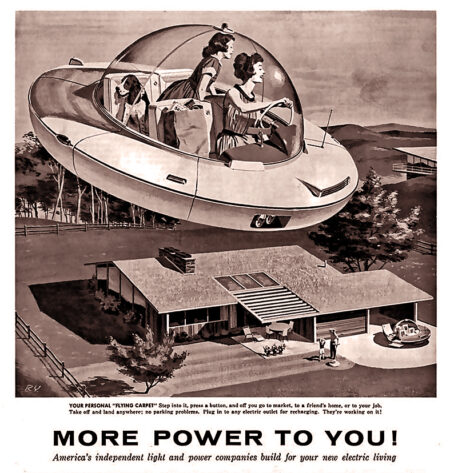The flying car future continues to be conveniently out of reach.
|
Listen To This Story
|
Maybe this is my own issue. Whenever I see a major publication run a feature on flying cars, I reconsider the merits of the prepper lifestyle. A nice underground bunker, yes, far away from The Future and its horrible enticements, and all the dehydrated meatloaf I can eat…
My hostility to flying cars surprises even me. I can’t believe I’d oppose something that would drive the 14-year-old me wild with desire. But that’s sort of the problem — flying cars are ideal for a world designed by teenage boys. Or the techno-optimists of Silicon Valley — basically teenage boys with venture capital — who have decided that our urban future should be in the air.
For about the last decade, there’s been a quiet arms race of investment and engineering among hundreds of startups, all trying to perfect the air vehicle of the future. To be used for what? Why, all sorts of things, boosters tell us: delivering medical supplies in Africa, or shuttling people around rural areas, or getting soldiers into and out of war zones.
Which are all reasonable use cases, not at all the kind of thing to drive a person underground. No. It’s all the talk of “air taxis” that becomes a problem for me. And possibly for you, depending on your feelings on scores of huge drones (or small helicopters, if you prefer) flying constantly overhead.
Part of my frustration is about the milquetoast way the whole thing has been covered. Every so often, an outlet like The Los Angeles Times, The New York Times, The Washington Post, USA Today, The Wall Street Journal, or any one of dozens of major or minor tech sites will ask some variation on the question of “When will the flying car arrive already?”
The story will dutifully interview a founder of one of the frontrunner startups in some Bay Area field or Silicon Valley warehouse, flush with cash from Google’s Larry Page or similar. It’ll describe how “flying cars” are a euphemism for what’s called “advanced aerial mobility” and concerns the development and deployment of battery-powered drone-type vehicles for transporting people and cargo. These are known as “eVTOLs,” short for “electric vertical takeoff and landing.” (Teen boys and techno-optimists are unified in their love of acronyms.)
The story always offers an estimated timeline for the arrival of advanced aerial mobility. This timeline is always two to three years out from public introduction, and maybe 10 or more years from general adoption. The Jetsons must be invoked; Blade Runner is optional. Somewhere around the three-quarter mark of the article, the author will dutifully, quickly talk through the obstacles: FAA regulation, battery life, airspace congestion, gravity. The story will end by reminding us of the timeframe — eh, a few years, basically a lifetime — and land on the closest thing to futurist optimism that its writers and editors can muster. Here’s how that NYT story sends us off:
They will be greener than helicopters and require less maintenance. They will be quieter, at least a little. And they may eventually be cheaper. One day, they could even fly on their own.
“Can we do this tomorrow morning? Probably not,” Mr. Thrun said. But if you squint your eyes and look at one of these prototypes, he added, you can see it happen.
These are fine reporters and strong writers who seem to go into the story inspired and come out of it deflated, or at least underwhelmed. Why then do these identical stories continue to roll out so regularly? Certainly the startups’ well-paid PR teams help, dangling a test flight or some baroque FAA development. But it’s really because of a culture-wide illusion we hold about the shape and direction of Progress.
Sci-fi writers of the early and middle 20th century (but as far back as good old 19th-century H.G. Wells) talk up a future in which the infrastructure of the city and the human body have been cleaned and perfected by technology. Flying cars, robots, artificial intelligence, cities on Mars: These fantasies continue to inspire generations of technologists and rich utopians. These are people who themselves seem like characters from speculative fiction, living vectors of irony who miss the fact that those sci-fi writers intended their stories as dystopian critique. When Mark Zuckerberg excitedly named Facebook’s virtual-reality project the “metaverse,” he was referencing the nightmarish digital wasteland of Neal Stephenson’s 1992’s Snow Crash. Zuck’s VR vision seems to have collapsed, but the ill-advised hat-tip still halfway survives in the company’s current name.
Among the tech set, this futurist drive has congealed into a kind of libertarian frustration that the past’s version of the future hasn’t come to pass, probably because we’re over-regulated cucks who prefer political correctness to mannish risk-taking. This frustration over a future denied is embodied in a 2021 book by a man named J. Storrs Hall called Where Is My Flying Car?
Hall’s question would seem to be answered (or “answered,” in the typically noncommittal way of all such news coverage) in a long piece in The New Yorker called “Are Flying Cars Finally Here?” The writer, Gideon Lewis-Kraus, says Hall’s thesis is “as a society, we’ve lost our taste for Promethean ambition — flying cars fell victim to ‘the wave of hostility and suspicion of technology’ that swept America.” Lewis-Kraus then more or less follows the formula for a flying car story: visits to the big players’ various warehouses and testing grounds; eccentric, engineering-minded, pioneering founders (always men); a history of deferred flying car ambitions from the mid-20th-century onward; a Jetsons mention; some caveats.
Lewis-Kraus is a good and wry and critical writer and raises eyebrows at all the right places, as when he suggests that an alternate solution to flying cars speeding people to distant Bay Area homes is that “the Bay Area could build more housing.” But this — and some other extremely valid critiques — are tucked-in and parenthetical to the story, rather than framed as central to our understanding of whether this will all work. That’s what makes these stories seem not just like tacit endorsements for the technology, but also bland and vague. Because flying cars may not work! And not talking about that makes a story bland and vague!
If it seems like I have the unhinged quality of a luddite who’s spent too much time in his underground shipping container thinking about this, that’s because I have. In 2020, LA’s then-mayor, Eric Garcetti, announced an “urban air mobility” (UAM) partnership that would yield “the introduction of low-noise, electric aircraft flying in our local airspace by 2023.” (That deadline came and went.) I reported a series of stories for KCRW — on delivery drones, on the Jetsonian futurist myth, and on why flying cars wouldn’t solve the traffic problem.
Here we are, two-and-a-half years later, and the future still seems just enough out of reach to be compelling to investors, founders, and journalists who all get to lean in without having to deal with the consequences. Everyone just gestures at The Promise of It All, as Lewis-Kraus does:
The 2028 Summer Olympics, in Los Angeles, may feature the ferrying of athletes through the air from the village to their stadiums. Regular civilians, or at least the courageous among them, could have access to such services by the end of the decade. One company promises a seven-minute trip from Manhattan to an airport, with an aspiration to land inside security; seat prices would eventually be competitive with rideshares. Proponents imagine a system of cheap, sustainable aerial transit — ribbons of humming vehicles interlaced overhead.
With apologies for deferring the critiques until late in my story (although I think I warned you), let me walk through the paradox of the urban flying car vision.

The consensus is that taking an air taxi will be expensive for the first… year? Two years? Unclear. So it’ll be one more luxury for the well-to-do, flying dystopically and disdainfully over the rest of us. But! say the boosters, eventually the price point will come down, and everyone can fly!
Okay, so now it’s democratized. What does that mean? Thousands or tens of thousands of vehicles in what is now relatively pristine airspace.
But, you might say, it’ll reduce traffic, right? The history of terrestrial highways suggests not.
Transportation researchers have thoroughly documented what’s called induced demand, in which adding more lanes does improve traffic in the short term, but as people cotton to that improved condition, they start using it more. Now there are just more lanes that are congested. If urban air mobility (UAM; another acronym) becomes as “easy” and “affordable” as regular cars, it’s reasonable to assume that at some point, the sky will be crowded, and the roads will be just as congested. As below, so above. (I’m not even getting into the “vertiports” scattered around town that will be the hubs for these vehicles, which present their own land-use and traffic issues.)
One study calculated that urban air mobility “does not provide a reduction in travel times” and “is likely to remain a niche mode of transportation for special purposes,” like emergency vehicles and rural routes. The flying car set is selling urban air mobility as a way of solving long-standing problems on the ground. But it’s not solving the ground; it’s abandoning it for greener skies … or whatever.
The flying car futurists dismiss all these critiques as just the sort of short-sightedness that tanked US nuclear power in the 1970s, or couldn’t anticipate the popularity of modern commercial air travel. But nuclear power is a fundamentally different energy paradigm from fossil fuels, whereas flying cars are just… cars, in a different place. And commercial air works because it is — though UAM proponents don’t mention this — just a more expensive kind of public transit.
The most futuristic application I can come up with, per the New Yorker story, is that urban air mobility will usher in an exciting new future for midlife crises — as a “white, over fifty, and male” customer opts for a flying car rather than a Corvette to “survey their vineyards” or “commute a dozen miles, from his ranch to his manufacturing plant.”
Lewis-Kraus’s story innovates on the flying car genre because he teases, and then delivers, a climactic solo flight in a flying car, called for some reason the BlackFly. What makes me so goddamn angry is that he does the unforgivable: He makes it sound awesome.
Once I leveled off, the propellers quieted to a much softer hum, and all at once I had a feeling of lightness and agility in the air. Below me were muddy ponds, glistening patterns of water and grass, a cluster of black cows. I crested through a long, slow turn over the base of the foothills, and the machine felt alive to my touch.
But I knew now that, if cruise weren’t disabled, I would have pushed the craft to whatever speed was available to me; I would have flown in the direction of the hills and the sky and never come back; I would be up there still.
Son of a bitch! I want to climb out of my bunker and try that out.
In any event, expect to hear more of this particular brand of reporting as we get closer to the Summer Olympics in Paris this year. The Olympics is traditionally where the world gets introduced to exciting new technologies, from the first televised sporting event in the 1936 Berlin games to those cardboard beds in the 2021 Tokyo games which powered a conspiracy theory about whether they were designed to keep the athletes from having sex.
The flying car lobby knows this, which is why there has been story after story about air taxis shuttling people around Paris. But true to the genre, European regulations aren’t likely to greenlight the flights, meaning the future will stay comfortably out of reach for a little bit longer. Two years. Maybe three. If not, there’s always the 2028 Olympics, which will be… let me just check my notes… here in Los Angeles. I’ll save you some meatloaf.
*WhoWhatWhy policy is to avoid AI image creation for all news content. In the case of this column and others on similar topics, however, we consider its use a fitting way to reckon with the changing media and technology landscape.





